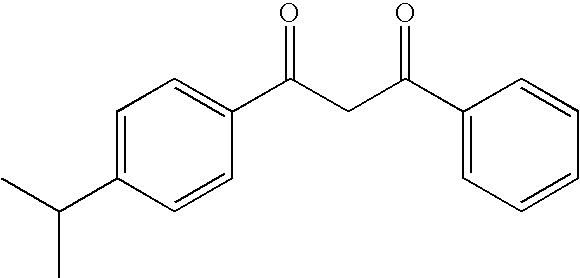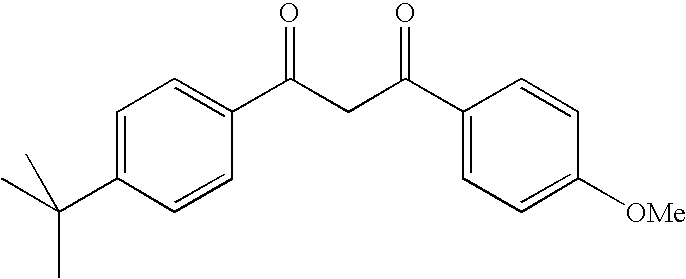Photostable sunscreen compositions comprising cinnamic acid ester UV-B filters, dibenzoylmethane UV-A filters and s-triazine compounds
a technology of uv-a filter and photostable composition, which is applied in the field of new sunscreen compositions, can solve the problems of loss of skin elasticity, premature cutaneous aging, and unfortunate tendency to decompose more or less rapidly, and achieve the effects of improving the chemical stability of the said uv-b screening agent, improving the effectiveness of the composition, and improving the chemical stability
- Summary
- Abstract
- Description
- Claims
- Application Information
AI Technical Summary
Benefits of technology
Problems solved by technology
Method used
Image
Examples
example 1
Synthesis of 2,4-bis(dineopentyl 4′-aminobenzalmalonate)-6-(butyl 4“-aminobenzoate)-s-triazine of formula (1)
[0229]
First Stage: Preparation of 2,4-dichloro-6-(butyl 4′-aminobenzoate)-s-triazine
[0230] Cyanuryl chloride (20.7 g, 0.112 mol) is dissolved at 0-5° C. in 250 ml of acetone in a reactor. A solution of butyl para-aminobenzoate (21.7 g, 0.112 mol) dissolved in 70 ml of acetone is added thereto dropwise at 0° C.-5° C. over 1 hour. Subsequently, sodium bicarbonate (9.4 g, 0.112 mol) dissolved in 70 ml of water is added thereto. The heterogeneous mixture is left at a temperature of 0° C.-5° C. for 2 hours. The precipitate formed is filtered off and then washed with water and with acetone. After drying under vacuum, 37.2 g (97% yield) of 2,4-dichloro-6-(butyl 4′-aminobenzoate)-s-triazine are obtained in the form of a white powder: [0231] UV (ethanol / DMSO): λmax=298 nm, E1%=940,
which is used as is in the following stage.
Second Stage: Preparation of the Compound of Example 1
[0...
example 2
Synthesis of 2,4-bis(dineopentyl 4′-aminobenzalmalonate)-6-(amyl 4″-aminobenzoate)-s-triazine of formula (2)
[0234]
First Stage: Preparation of 2,4-dichloro-6-(amyl 4′-aminobenzoate)-s-triazine
[0235] Cyanuryl chloride (14.7 g, 0.0796 mol) is dissolved in 200 ml of dioxane at 10° C. in a reactor. A solution of amyl para-aminobenzoate (16.5 g, 0.0796 mol) dissolved in 60 ml of dioxane and a solution of potassium carbonate (5.5 g, 0.0398 mol) dissolved in 30 ml of water are simultaneously added thereto dropwise at 10° C. over 1 hour. The heterogeneous mixture is left at a temperature of 10° C. for 2 hours. Approximately 300 ml of water are added and the precipitate formed is filtered off and then washed with water. After drying under vacuum, 26.4 g (93% yield) of 2,4-dichloro-6-(amyl 4′-aminobenzoate)-s-triazine are obtained in the form of a white powder used as is in the following stage.
Second Stage: Preparation of the Compound of Example 2
[0236] The intimately mixed mixture of the ...
example 3
Synthesis of 2,4-bis(dineopentyl 4′-aminobenzalmalonate)-6-(2-ethylhexyl 4″-aminobenzoate)-s-triazine of formula (3)
[0238]
First Stage: Preparation of 2,4-dichloro-6-(2-ethylhexyl 4′-aminobenzoate)-s-triazine
[0239] Cyanuryl chloride (18.4 g, 0.1 mol) is dissolved at 0° C.-5° C. in 150 ml of acetone in a reactor. Sodium bicarbonate (10.6 g, 0.1 mol) is added thereto and then a solution of 2-ethylhexyl para-aminobenzoate (24.9 g, 0.1 mol) dissolved in 150 ml of acetone is added dropwise at a temperature of less than 10° C. over 10 minutes. Subsequently, the heterogeneous mixture is left at laboratory temperature for 3 hours. 500 ml of water are run in. The precipitate formed is filtered off and then washed with water. After drying under vacuum, 38 g of an off-white solid are obtained. After recrystallizing this solid from 1,2-dichloroethane, 25.2 g (63% yield) of 2,4-dichloro-6-(2-ethylhexyl 4′-aminobenzoate)-s-triazine are obtained in the form of a white powder: [0240] UV (ethanol / D...
PUM
| Property | Measurement | Unit |
|---|---|---|
| wavelengths | aaaaa | aaaaa |
| wavelengths | aaaaa | aaaaa |
| wavelengths | aaaaa | aaaaa |
Abstract
Description
Claims
Application Information
 Login to View More
Login to View More - R&D
- Intellectual Property
- Life Sciences
- Materials
- Tech Scout
- Unparalleled Data Quality
- Higher Quality Content
- 60% Fewer Hallucinations
Browse by: Latest US Patents, China's latest patents, Technical Efficacy Thesaurus, Application Domain, Technology Topic, Popular Technical Reports.
© 2025 PatSnap. All rights reserved.Legal|Privacy policy|Modern Slavery Act Transparency Statement|Sitemap|About US| Contact US: help@patsnap.com



